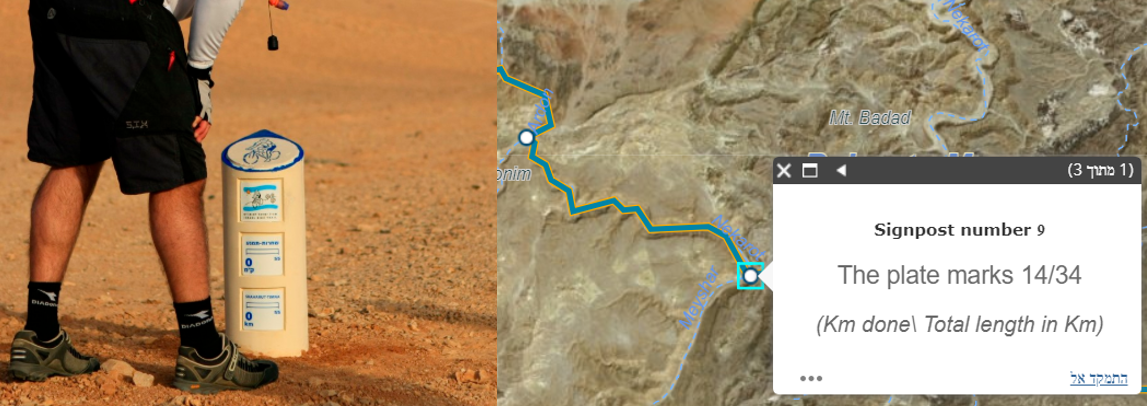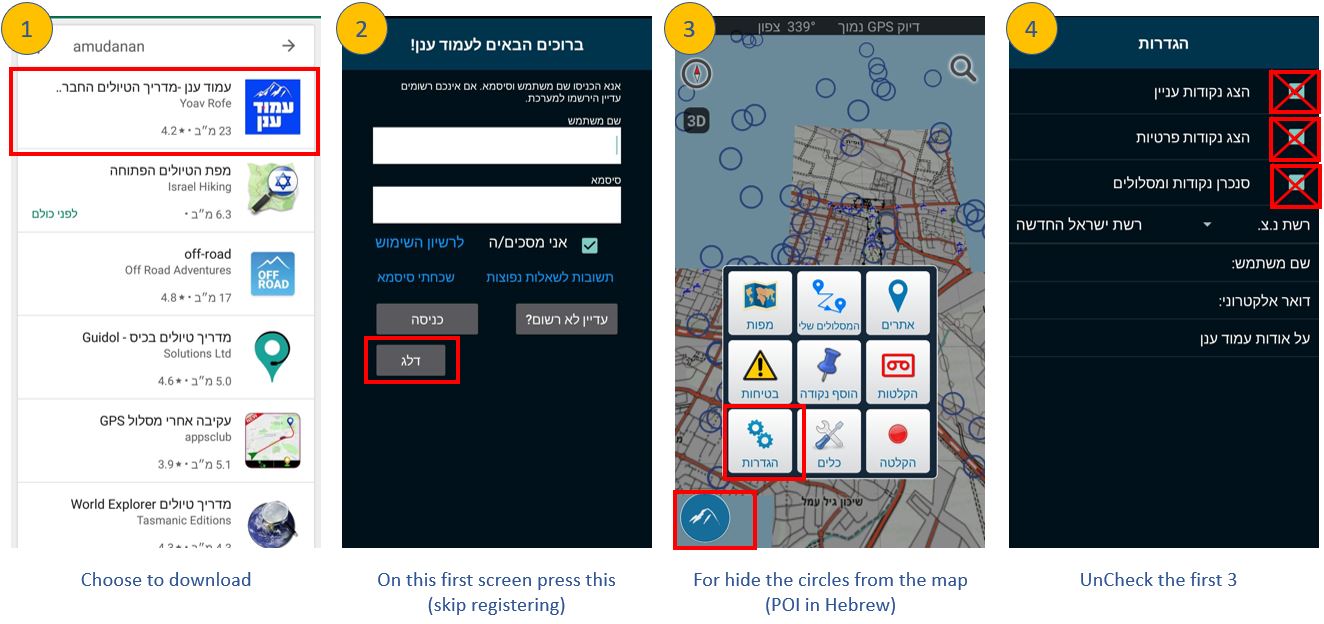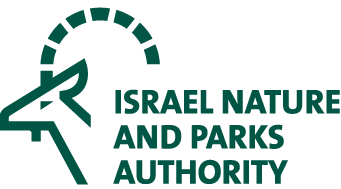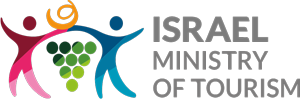The small state of Israel is a mountain biker’s paradise. Throughout its 600 km longitude and 100 km width, it offers many trails, for all kinds of riding styles and skills, crossing and connecting different landscapes and cultures.
From the Golan heights in the north, through the mountains and sea shore in the center, to the desert in the south, most of the trails are free to travel and thus offering an ultimate freedom for riding.
Riding the Israel Bike Trail (IBT)offers experiencing a variety of landscapes, sceney, cultures and unique sites that Israel has to offer.
Why Riding Israel Bike Trail
Israel Bike Trail (IBT) is a ride of a lifetime through this fascinating country. The trail is running from north to south, connecting the most important points of interest and sights in Israel. The marked trail is now covering the southern part ot the country, connecting Mizpe Ramon and Eilat. This part is well marked and well maintained and many local trails are in a short distance from it. Those who have time on their hands can experience these trails and meet the local riders as well.
When is The best time to ride the trail
Israel enjoys most of the year a Mediterranean weather which is suitable for riding, . The variety of landscapes gives the rider many options to choose from, according to the weather conditions. At summer time (July - August) the entire country gets hot (and humid in the central areas) and therefore makes it very difficult to ride throughout the day .
During the winter, the temperature drops making the southern area (the Negev) suitable for riding. The central and northern parts of the country become pretty rainy which will probably cause muddy trails. Usually, single tracks become rideable one or two days after raining.
In general there are four main weather zones:
- The Negev (south of Be’er sheva)
The Negev is an arid and hot region, best for riding during the winter. This area becomes difficult to ride during daylight, due to high temperatures from late March to early November.
- Jerusalem area
This is a year-around riding area. The relatively high altitude (600-800 meters) and the distance from the Mediterranean Sea provide optimal conditions for riding. The air is cool and dry, the temperatures are not getting too high and the rocky trails will not get muddy after every rain.
- Central Israel (Be’er Sheva to Haifa)
The best time of the year for riding here is from spring to early summer (March to June) and autumn (End of September to November).
- Galilee and Golan Heights
While the winter is the best time for riding in the southern parts of the trail, it is a bit less suitable for its northern segments.
The trail is rideable depending on the time passed since the last rain (no rain for 2-3 days is OK) and on the trail’s bedding. At the rainy period of the year (December to March) it is advised to examine the trail’s characteristics in order to make the right decision.
Here is a map that will make it easier to describe:
Navigating along the trail
The trail is well marked.
Along the trail you will meet four kind of milestones: A ‘welcome sign’ at the trailhead of each segment, A short concrete pillar for every 5-10 kilometers and, more often, blue/white signs marked on rocks or stones, and 'wing' signs.
Please note! Israel has a rich network of hiking trails. In some parts the IBT trail and other local trail might merge and share the same route. This is where you might get a little confused so just remember to keep track on the Israel Bike Trail and Follow IBT signs only:
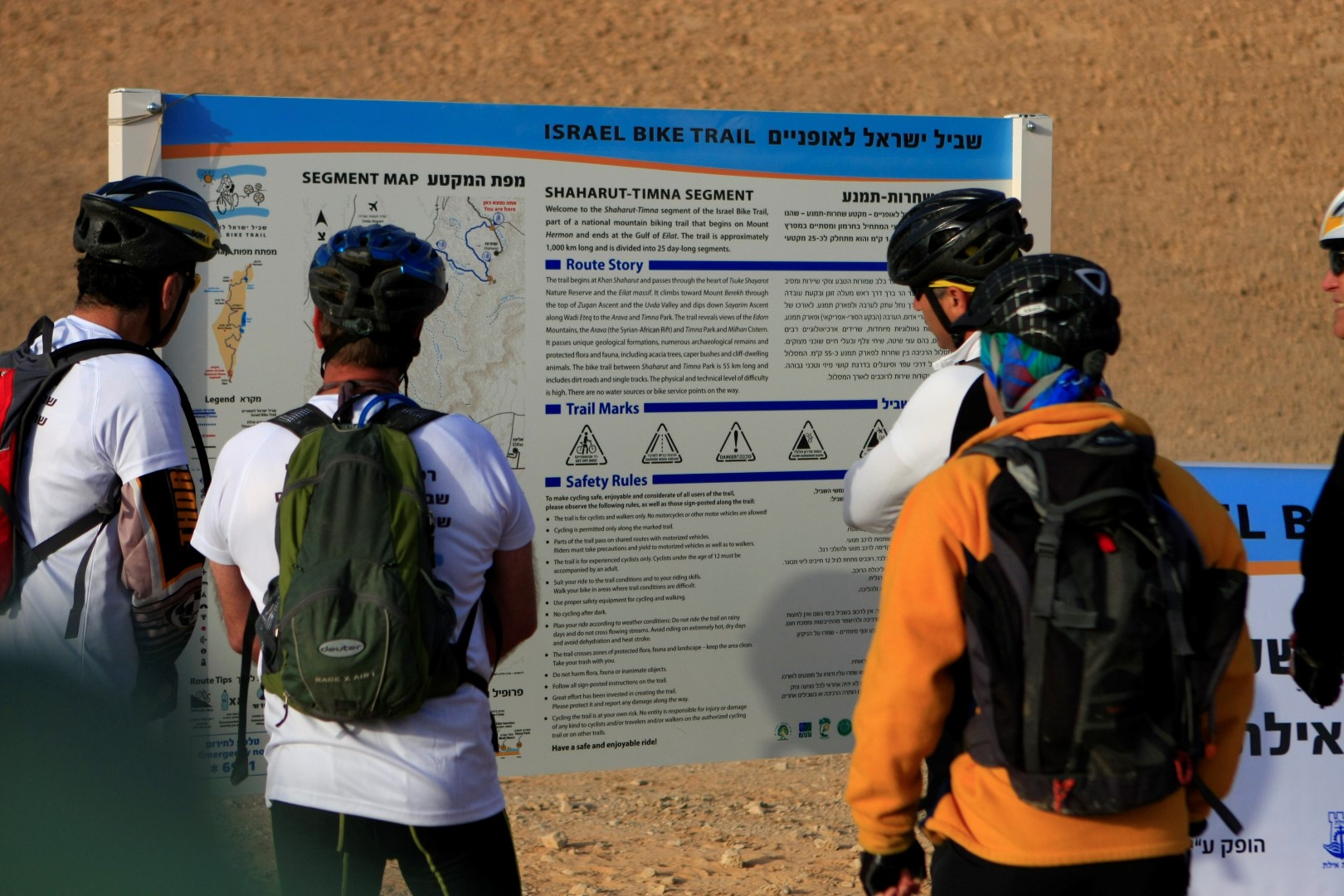 Each segment starts with a welcome sign |
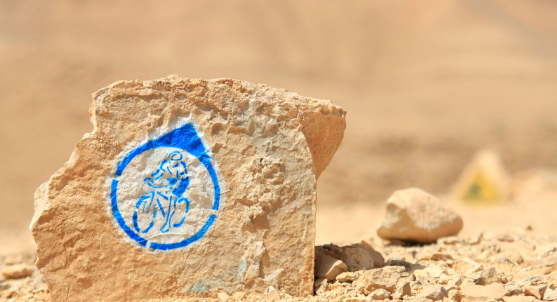 blue/white signs marked on rocks or stones |
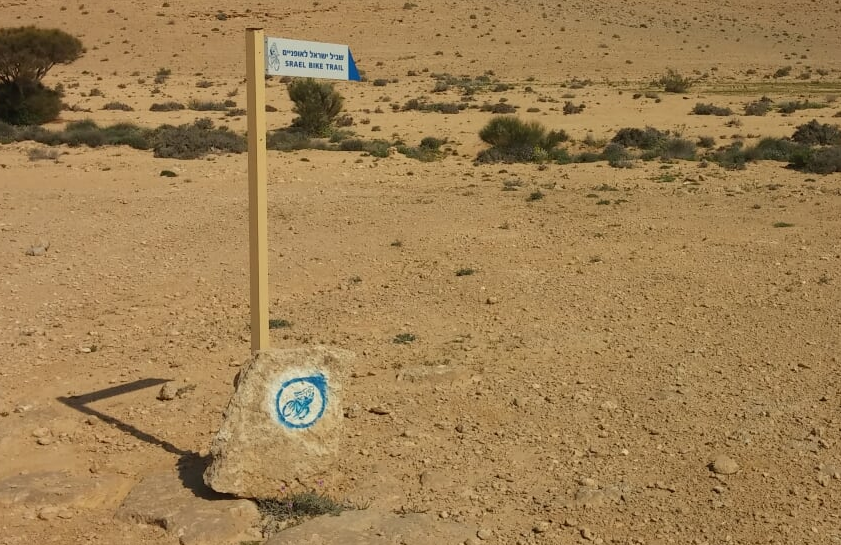 'wing' sign |
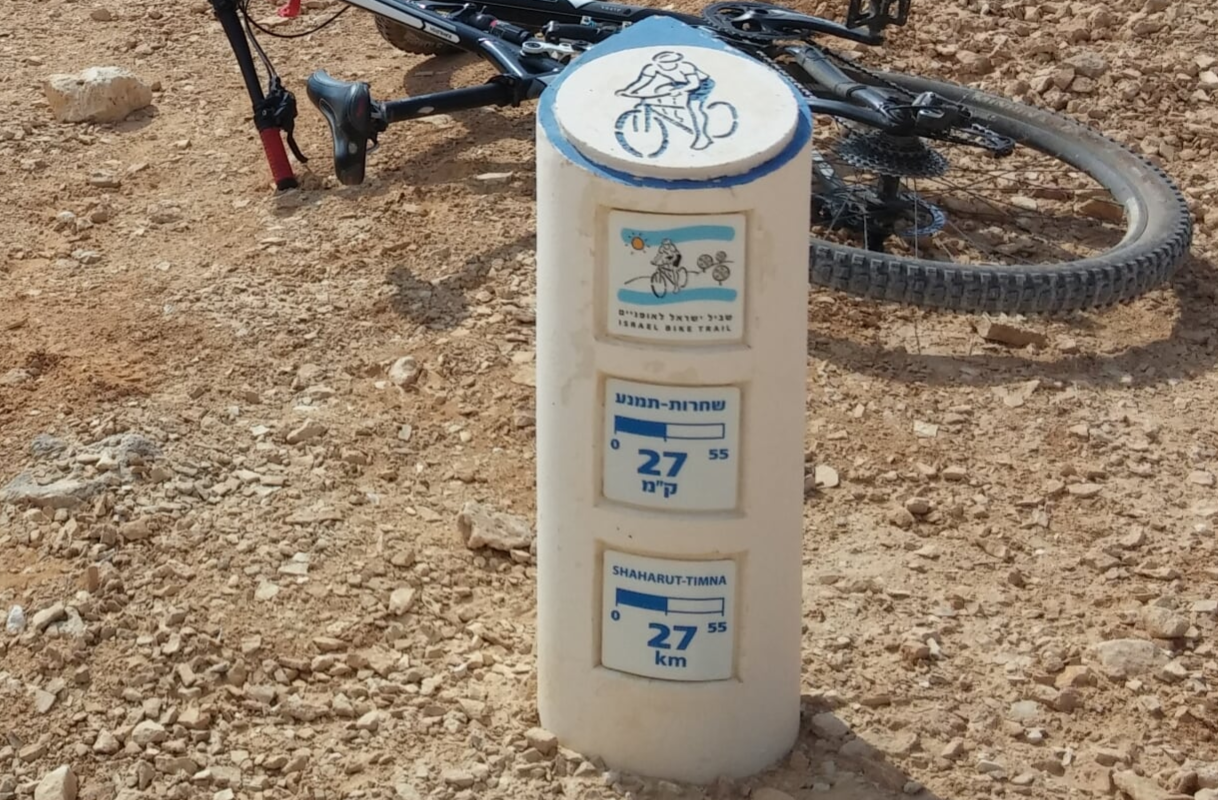 A short concrete pillar for every few kilometers |
Signposts are mapped and display on the segment's map
Maps and resources
-
For navigation and local trail’s information, you might find these sites useful:
- Israel Hiking map (hebrew): https://israelhiking.osm.org.il
- Amudanan. Mobile application (Hebrew) with very useful maps, including trails colors marks. look for it on google play\ App store
How to start it:
Moving around and getting to The trail
There are several options to get around the country with your bike:
- Bus
- Train
- Private shuttle
Do keep in mind that all public transportations are not available from Friday afternoon to Saturday evening and during religious holidays.
Using the bus
Israel has a well-developed network of bus lines. You can use the bus to get almost everywhere. Sometimes without even changing bus lines.
In order to get to Israel bike trail trailheads or to get from the trail back, you may find the bus service pretty useful. In each of the segment’s maps we show the locations of the relevant bus stations.
What is written on the bus station?
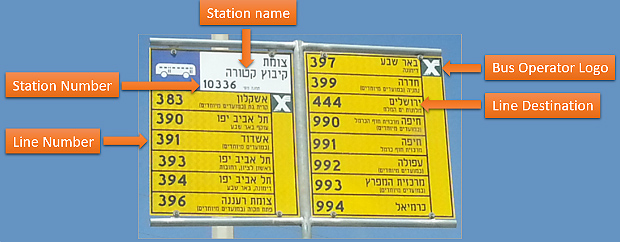 |
|
The trunk of intercity bus service |
Long-distance buses have a large trunk that allows bike storing. Basically the bike can be put in the trunk without dismantling it unless the trunk is already taken by other passengers’ luggage. No additional fee for bikes requested. For price, planning and bus stops locations, please use the link: Bus.co.il Free mobile phone applications: Moovit (Android / IOS ) Try to avoid using the bus services during Thursdays afternoon, Saturdays evenings and Sundays morning due to heavy loads on public transport lines and therefore much packed bus cargo cells. |
Using the train
Israel Train service is working all week and like all public transportation does not work from Friday afternoon to Saturday evening and on religious holidays.
Train lanes connect most of the big cities in the north and center of Israel and Beer Sheva in the south.
Bicycle policy
|
|
|
|
|
There is no extra fee. To learn more including booking tickets : http://www1.rail.co.il/en/Pages/Homepage.aspx
Using Private services
At remote areas where adequate public transportation services are not available, you may find private transportation services at the local communities.
These services are mostly private provided by local residents who are reliable trustworthy.
In order to help you locate the relevant service provider, we have listed and mapped some of them.
You are welcome to use the list on the site or turn on the “services” layer on the segment’s map.
Please keep in mind that the cost depends on the travel distance from the picking point to the destination. There are no relevant regulations.
There is also the option of using Taxi services. For those - look for taxi station and do not forget to mention that you have a bicycle to carry.
Food and Water along the trail
Food
|
|
Israel is well known for its quality and variety of “street food”. Beside restaurants you can find plenty of bars, kiosks, food stalls and convenience stores at gas stations (usually open 24/7). Supermarkets (groceries) can be found at all places where people live. You should check for opening hours in advance. Common hours are from 8:00 to 19:00 The most known food in Israel are the Hummus, Falafel and Shawarma. All are very tasty and good for rider’s diet (at the end of the riding day). It is safe to eat anywhere with no worry. |
Water
In general, Israel provides high quality water so you can drink straight from the water tap (faucet).
Along the southern segments of the trail, water sources are scarce.
Drinking water can be found at gas stations, settlements and any developed sites on the way. Jewish cemeteries are also a place where you can find fresh water.
Natural water sources can be found, here and there, but be aware! Most of them are contaminated and are not suitable for drinking.
DO NOT DRINK from Wadis, any of the rivers along the Mediterranean coast and Zin wadi (south)
We mapped the available drinking water spots along the segments, which are not in obvious places. These are displayed in the segments maps.
Security and safety
Along the whole trail, as well as in the rest of the cycle routes in the country, there are no security problems whatsoever. To date, no case has been reported of harassment / assault or theft.
The only thefts that were reported were of food bags by wild animals.
Breaking into cars parked in remote places is a familiar phenomenon and therefore it is recommended not to leave a vehicle in isolated places for long time. It is recommended to park at supervised places.
Cellular
In general, Israel is well covered by the cellular network.
Remote places, Mostly in its southern part and especially along wadis (dry river bed) are expected to have poor or no signal.
The segment's map shows these poor signal reception areas. Please refer the relevant map.
Accommodation
Along Israel bike trail there are all kinds of accommodations, from 5-star hotels (in the cities),through hostels ans cabins at every Moshav and Kibbutz (Country Lodging), to 1,000,000 stars under the Negev sky.
|
Camping sites The most basic option (and the cheapest). Campsites can be just a defined area, marked with a sign (signpost campgrounds) or they could be a part of a big compound. The ones that will charge night fee will offer showers or even food services (please check first). Relevant campsites locations are available on the segments map. |
Signpost campsites” near Masada |
|
Khan (Camplodge) The modern version for Bedouin hospitality camp. Like in the old days, this compound offers logistics services such as sleeping place in a large tent (including mattresses, not including sheets, pillows or blankets). It also includes hot showers, toilets and food services. Most Khans has a designated place to set up your own tent. Khans can offer meals with advance order and usually will not have any food services avilable on site. More information and locations of Khans and campsites are available on the segments maps in the website. In hostels, cabins a a Moshav or a Kibbutz (Country Lodging) it is important to book in advance camper needs. Relevant Khans locations are available on the segments map. |
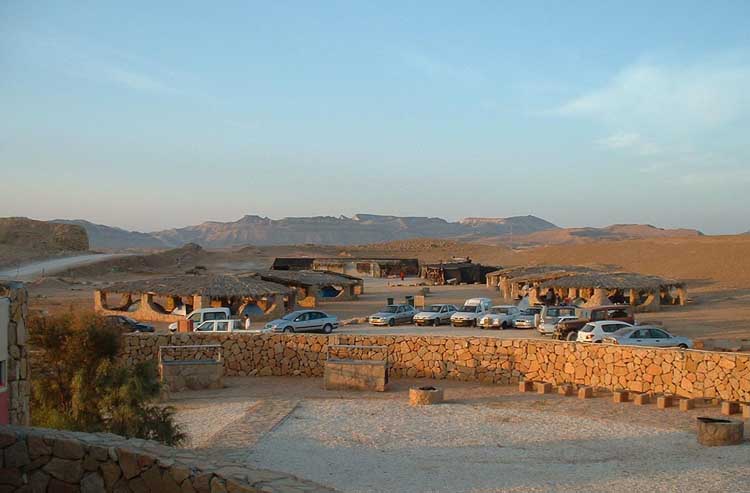 Khan |
Financial stuff
In Israel, almost all credit cards are accepted. The use of foreign currency for payment is not possible except at hotels and tourist businesses.
In big cities and mid-size towns, exchange services can be found. All Cash machines will provide cash in local currency.
There are also cash withdrawal machines (ATM) that are placed throughout the country in a variety of businesses, entertainment sites, retail chains, shopping centers and more.
Limited access zones
Military zones
Most of the army's training areas are located at the northern and southern parts of the country. In order to ride those areas you will have to coordinate in advance. (not a permit).
In general, Israel bike Trail does not pass through fire zones and except for one segment, where one should notify for its entrance, other sections do not require any coordination whatsoever.
The training areas are clearly marked and there is no fear of traveling along Israel bike Trail.
Nature reserves
Nature Reserves and National Parks have clear rules regarding cycling. In general, it is allowed to ride only on marked trails.
Riding or walking on an unmarked trail is prohibited!
Please notice that not all pedestrian paths are allowed for cycling.
Staying in a nature reserve after day hours (around 17:00) are prohibited.
Desert riding in general...
We have dedicated an article for that matter, but here are the main tips.
Know your way - It is best to take a guide / escort if you do not have experience riding in the desert.
Day\ Night - The weather tends to be extreme cold at night and hot during the day. Be prepared.
Floods - in the desert, especially during the transitional seasons and winter, there is a good chance of stream floods. Make sure you are updated regarding the weather forecast before starting the trail.. Ask people on the way.
Local residents – Scorpions and snakes are not rare in the wild. Dangerous encounters are pretty rare. Just be careful, look around and you will be safe. Do not turn over rocks; Pay attention and stay away from burrows.
The sun - In the southern parts of the trail, shaded spots are scarce. Plan your ride in a way you‘ll spend the most of it during the cool hours. Shade spots in the southern trail segments are mapped and may be displayed in the segments’ maps.
Dehydration - One of the common dangers. Always carry enough water (at least 1 litter per 10 km) and make sure to drink at least 3-4 times an hour.
Hyperthermia\ heat stroke – is also one of the common dangers of riding at hot places.
Hyperthermia is elevated body temperature that occurs when a body produces or absorbs more heat than it dissipates. It is caused by exposure to excessive heat, or combination of heat and humidity. It has nothing to do with dehydration. Always look for alerting signs such as confusion, red face and disorientation.
General facts
Cellular networks - Most of the trail segments are covered well by the mobile networks. In case of no signal, try to climb to an elevated point. Usually it works. You can learn more about the coverage from the segment's map.
Navigation - Although the entire path is marked, it is recommended to travel with a printed map as well. A navigation device is also recommended.
Fences - Never cross a fence! When travelling close to the international border (Jordan) - it is forbidden to get off the path.
Emergency calls: 100
For more information it is advised to visit: https://info.goisrael.com/en/
We wish you a pleasant and joyful ride and hope you will have a great experience riding Israel bike Trail.
Ride With the locals
Israel has several "Meccas" for MTB enthusiasts. Here are some of the most popular riding areas in the country:
Alon Hagalil
A well-known MTB trailhead hub for the Galil area. bike shop and friendly staff will be happy to serve. Maps and other logistic services are also available.
http://4x4bike.co.il/index.aspx
Ben Shemen forest
The largest MTB area in center of Israel. This is a nation scale ‘Mecca’ for single tracks enthusiastic riders. On weekends, there are hundreds of riders gathering in this forest.
http://www.eyarok.org.il/bike/maintrip.aspx?id=2
Adolam and Britania national park
A vast area of moderate hills and forest, spotted with dozens of archeological sites and man-made caves from the Roman times.
Kibutz Be’eri area
More than 120 km of single trails on mild hills topography make this site one of the favorites in the country for all riding levels. The trails are well maintained and planned to maximize the single trail riding thrill. At the trailhead hub there is a nice cafeteria and a professional bike shop.
Sde Boker area
This wide desert area, only an hour and a half drive from Tel Aviv, offers more than 100 km of single tracks. Most of them start and end at the Sde Boker College and field school. In the small commercial center there are several restaurants and one of the biggest bike shop in the area where you can also find bicycle to rent.
Timna Park
Located not far from Eilat city, Timna National park offers beautiful scenery, interesting geological phenomena and archaeological sites, all connected by bicycle trails and park roads. There are also many activities for the whole family to enjoy.
http://www.parktimna.co.il/EN/
See ya!
Noam

